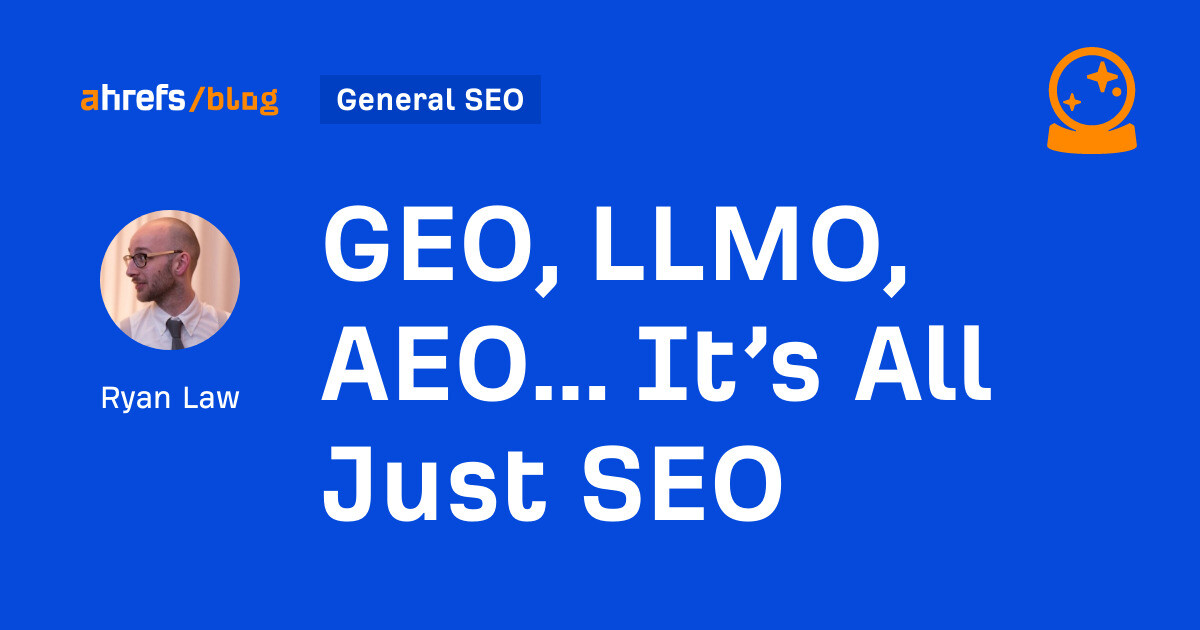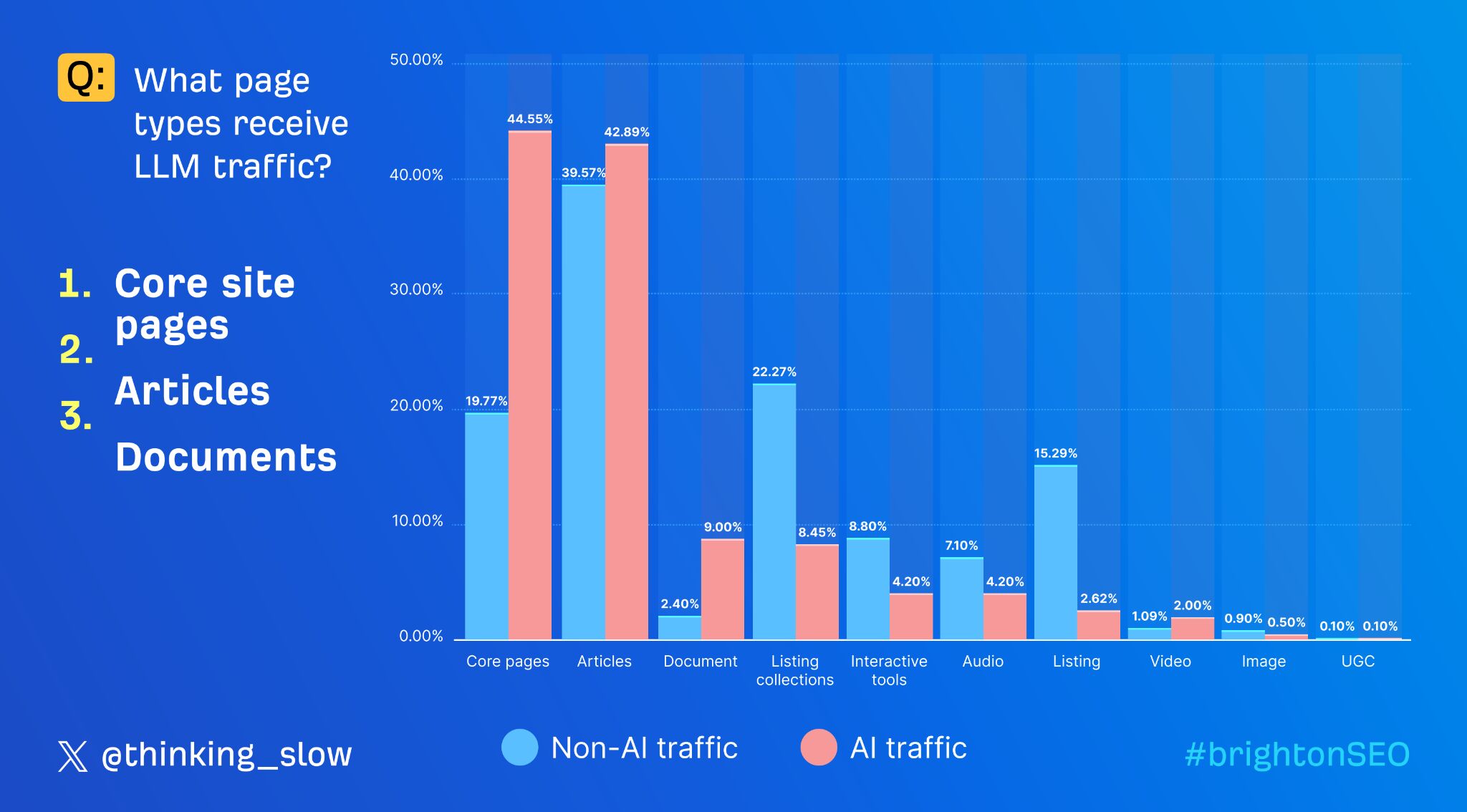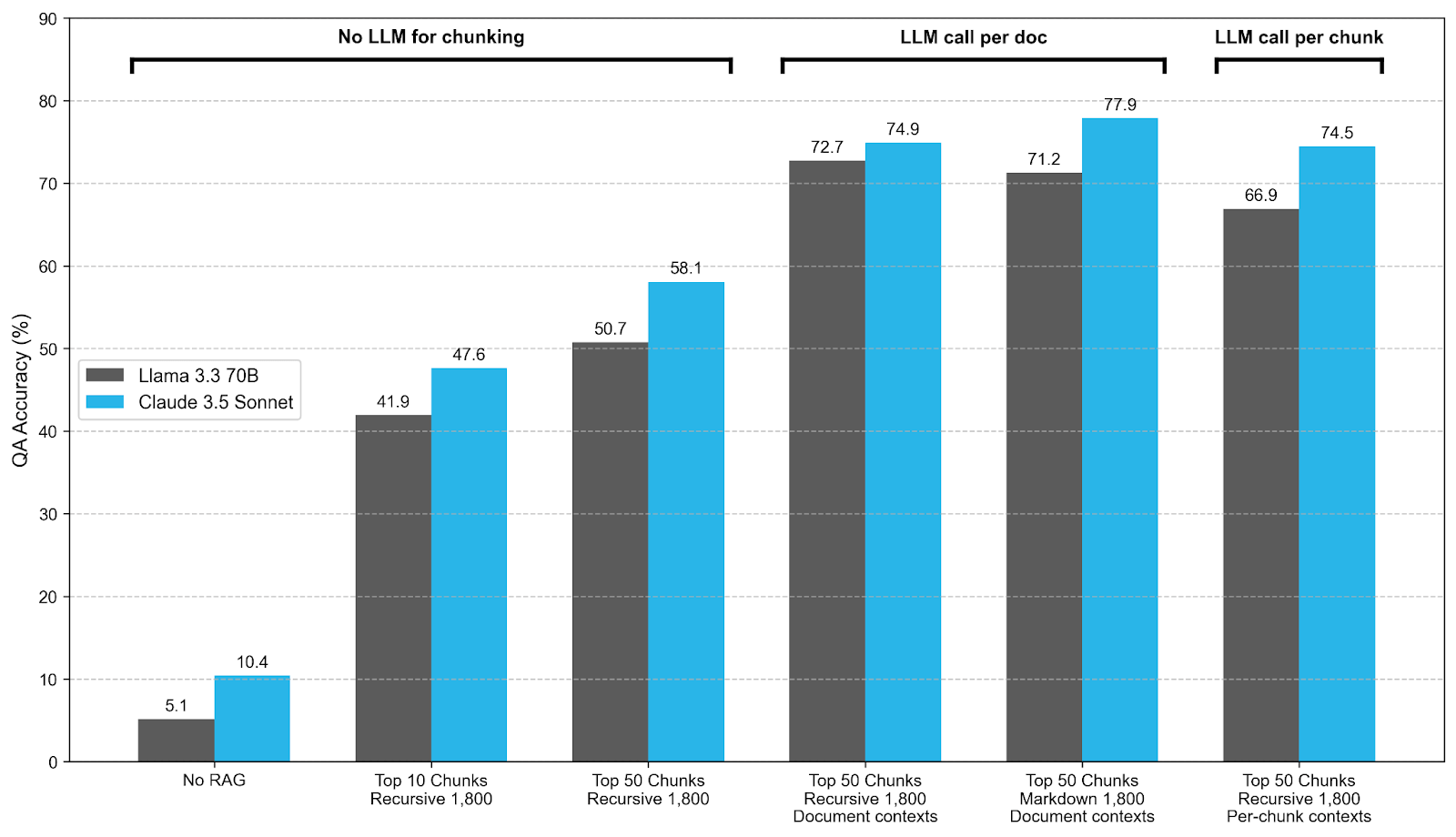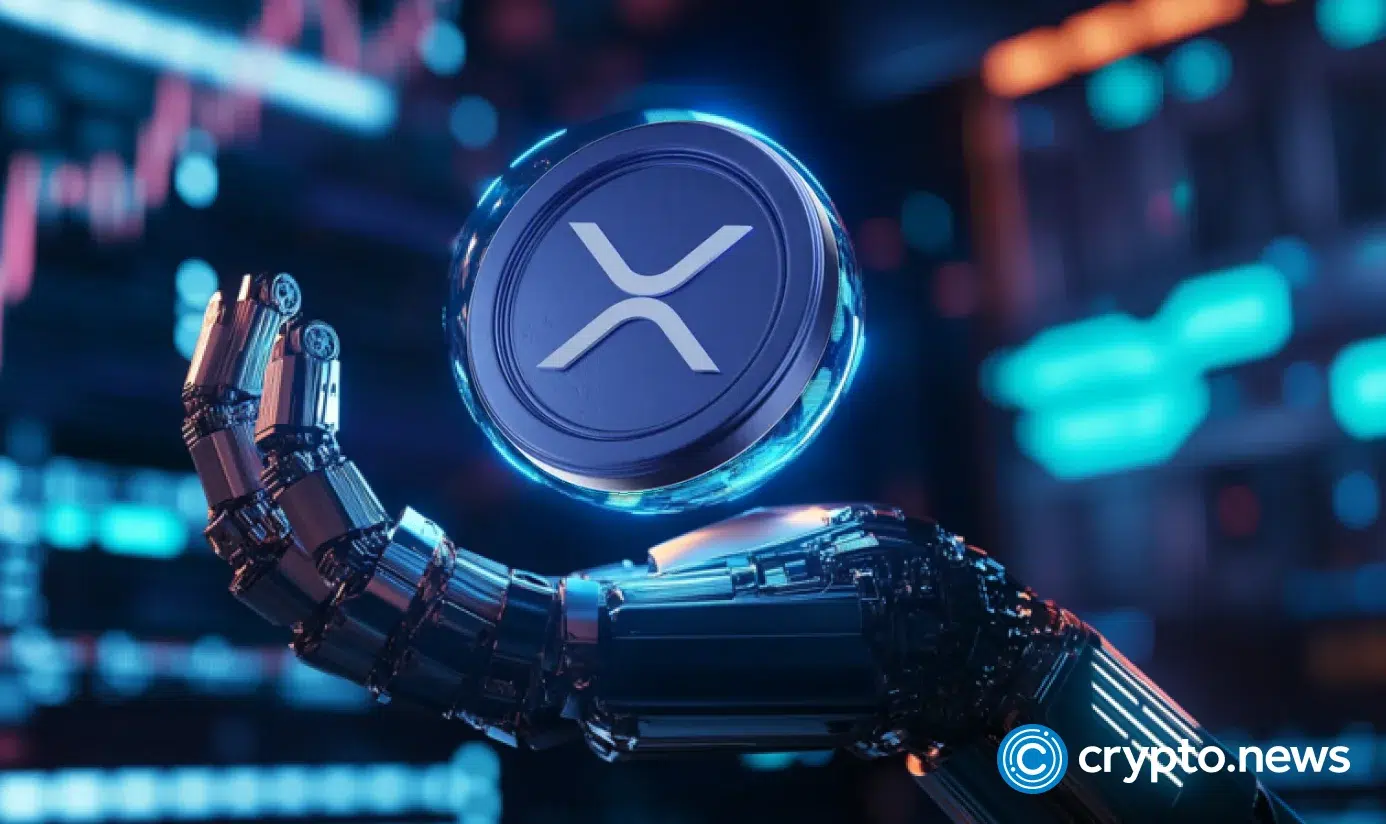GEO, LLMO, AEO… It’s All Just SEO
So far, it doesn’t seem like it. There seems to be massive overlap in SEO and GEO, such that it doesn’t seem useful to consider them distinct processes. The things that contribute to good visibility in search engines also...

As a marketer, I want to know if there are specific things I should do to improve our LLM visibility that I am not currently doing as part of my routine marketing and SEO efforts. So far, it doesn’t seem like it. There seems to be massive overlap in SEO and GEO, such that it doesn’t seem useful to consider them distinct processes. The things that contribute to good visibility in search engines also contribute to good visibility in LLMs. GEO seems to be a byproduct of SEO, something that doesn’t require dedicated or separate effort. If you want to increase your presence in LLM output, hire an SEO. Sidenote. GEO is “generative engine optimization”, LLMO is “large language model optimization”, AEO is “answer engine optimization”. Three names for the same idea. It’s worth unpacking this a bit. As far as my layperson’s understanding goes, there are three main ways you can improve your visibility in LLMs: Large language models are trained on vast datasets of text. The more prevalent your brand is within that data, and the more closely associated it seems to be with the topics you care about, the more visible you will be in LLM output for those given topics. We can’t influence the data LLMs have already trained on, but we can create more content on our core topics for inclusion in future rounds of training, both on our website and third-party websites. Creating well-structured content on relevant topics is one of the core tenets of SEO—as is encouraging other brands to reference you within their content. Verdict: just SEO. LLMs increasingly use external data sources to improve the recency and accuracy of their outputs. They can search the web, and use traditional search indexes from companies like Bing and Google. OpenAI’s VP Engineering on Reddit confirming the use of the Bing index as part of ChatGPT Search. It’s fair to say that being more visible in these data sources will likely increase visibility in the LLM responses. The process of becoming more visible in “traditional” search indexes is, you guessed it, SEO. LLMs are prone to manipulation, and it’s possible to trick these models into recommending you when they otherwise wouldn’t. These are damaging hacks that offer short-term benefit but will probably bite you in the long term. This is—and I’m only half joking—just black hat SEO. To summarize these three points, the core mechanism for improving visibility in LLM output is: creating relevant content on topics your brand wants to be associated with, both on and off your website. That’s SEO. Now, this may not be true forever. Large language models are changing all the time, and there may be more divergence between search optimization and LLM optimization as time progresses. But I suspect the opposite will happen. As search engines integrate more generative AI into the search experience, and LLMs continue using “traditional” search indexes for grounding their output, I think there is likely to be less divergence, and the boundaries between SEO and GEO will become even smaller, or nonexistent. As long as “content” remains the primary medium for both LLMs and search engines, the core mechanisms of influence will likely remain the same. Or, as someone commented on one of my recent LinkedIn posts: “There’s only so many ways you can shake a stick at aggregating a group of information, ranking it, and then disseminating your best approximation of what the best and most accurate result/info would be.” I shared the above opinion in a LinkedIn post and received some truly excellent responses. Most people agreed with my sentiment, but others shared nuances between LLMs and search engines that are worth understanding—even if they don’t (in my opinion) warrant creating the new discipline of GEO: This is probably the biggest, clearest difference between GEO and SEO. Unlinked mentions—text written about your brand on other websites—have very little impact on SEO, but a much bigger impact on GEO. Search engines have many ways to determine the “authority” of a brand on a given topic, but backlinks are one of the most important. This was Google’s core insight: that links from relevant websites could function as a “vote” for the authority of the linked-to website (a.k.a. PageRank). LLMs operate differently. They derive their understanding of a brand’s authority from words on the page, from the prevalence of particular words, the co-occurrence of different terms and topics, and the context in which those words are used. Unlinked content will further an LLM’s understanding of your brand in a way that won’t help a search engine. As Gianluca Fiorelli writes in his excellent article: “Brand mentions now matter not because they increase ‘authority’ directly but because they strengthen the position of the brand as an entity within the broader semantic network. When a brand is mentioned across multiple (trusted) sources: The entity embedding for the brand becomes stronger. The brand becomes more tightly connected to related entities. The cosine similarity between the brand and related concepts increases. The LLM ‘learn’ that this brand is relevant and authoritative within that topic space.” Many companies already value off-site mentions, albeit with the caveat that those mentions should be linked (and dofollow). Now, I can imagine brands relaxing their definition of a “good” off-site mention, and being happier with unlinked mentions in platforms that pass little traditional search benefit. As Eli Schwartz puts it, “In this paradigm, links don’t need to be hyperlinked (LLMs read content) or restricted to traditional websites. Mentions in credible publications or discussions sparked on professional networks (hello, knowledge bases and forums) all enhance visibility within this framework.” Track brand mentions with Brand Radar You can use our new tool, Brand Radar, to track your brand’s visibility in AI mentions, starting with AI Overviews. Enter the topic you want to monitor, your brand (or your competitors’ brands), and see impressions, share of voice, and even specific AI outputs mentioning your brand: I think the inverse of the above point is also true. Many companies today build backlinks on websites with little relevance to their brand, and publish content with no connection to their business, simply for the traffic it brings (what we now call site reputation abuse). These tactics offer enough SEO benefit that many people still deem them worthwhile, but they will offer even less benefit for LLM visibility. Without any relevant context surrounding these links or articles, they will do nothing to further an LLM’s understanding of the brand or boost the likelihood of it appearing in outputs. Some content types have relatively little impact on SEO visibility but greater impact on LLM visibility. We ran research to explore the types of pages that are most likely to receive traffic from LLMs. We compared a sample of pageviews from LLMs and from non-LLM sources, and compared the distribution of those pageviews. We found two big differences: LLMs show a “preference” for core website pages and documents, and a “dislike” for listing collections and listings. Citation is more important for an LLM than a search engine. Search engines generally surface information alongside the source that created it. LLMs decouple the two, creating an extra need to prove the authenticity of whatever claim is being made. From this data, it seems the majority of citations fall into the “core site pages” category: a website’s home page, pricing page, or about page. These are crucial parts of a website, but not always big contributors to search visibility. Their importance seems greater for LLMs. A slide from my brightonSEO talk showing how AI and non-AI traffic is distributed across different page types. Inversely, listings pages—think big breadcrumbed Rolodexes of products—that are created primarily for on-page navigation and search visibility received far fewer visits from LLMs. Even if these page types aren’t cited often, it’s possible that they might further an LLM’s understanding of a brand because of the co-occurrence of different product entities. But given that these pages are usually sparse in context, they may have little impact. Lastly, website documents also seem more important for LLMs. Many websites treat PDFs and other forms of documents as second-class citizens, but for LLMs, they are a content source like any other, and they routinely cite them in their outputs. Practically, I can imagine companies treating PDFs and other forgotten documents with more importance, on the understanding that they can influence LLM output in the same way any other site page would. The point that LLMs can access website documents raises an interesting point. As Andrej Karpathy points out, there may be a growing benefit to writing documents that are structured first and foremost for LLMs, and left relatively inaccessible to people: “It’s 2025 and most content is still written for humans instead of LLMs. 99.9% of attention is about to be LLM attention, not human attention. E.g. 99% of libraries still have docs that basically render to some pretty .html static pages assuming a human will click through them. In 2025 the docs should be a single your_project.md text file that is intended to go into the context window of an LLM. Repeat for everything.” This is an inversion of the SEO adage that we should write for humans, not robots: there may be a benefit to focusing our energy on making information accessible to robots, and relying on the LLMs to render the information into more accessible forms for users. In this way, there are specific information structures that can help LLMs correctly understand the information we provide. For example, Snowflake refers to the idea of “global document context”. (H/T to Victor Pan from HubSpot for sharing this article.) LLMs work by breaking text into “chunks”; by adding extra information about the document throughout the text (like company name and filing date for financial text), it’s easier for the LLM to understand and correctly interpret each isolated chunk, “boosting QA accuracy from around 50%-60% to the 72%-75% range.” Understanding how LLMs process text offers small ways for brands to improve the likelihood that LLMs will interpret their content correctly. LLMs also train on novel information sources that have traditionally fallen outside the remit of SEO. As Adam Noonan on X shared with me: “Public GitHub content is guaranteed to be trained on but has no impact on SEO.” Coding is arguably the most successful use case for LLMs, and developers must make up a sizeable portion of total LLM users. For some companies, especially those selling to developers, there may be a benefit to “optimizing” the content these developers are most likely to interact with—knowledgebases, public repos, and code samples—by including extra context about your brand or products. Lastly, as Elie Berreby explains: “Most AI crawlers do not render JavaScript. There’s no renderer. Popular AI crawlers like those used by OpenAI and Anthropic do not even execute JavaScript. That means they won’t see content that is rendered client-side through JavaScript.” This is more of a footnote than a major difference, for the simple reason that I don’t think this will remain true for very long. This problem was solved by many non-AI web crawlers, and will be solved by AI web crawlers in short order. But for now, if you rely heavily on JavaScript rendering, a good portion of your website’s content may be invisible to LLMs. But here’s the thing: managing indexing and crawling, structuring content in machine-legible ways, building off-page mentions… these all feel like the classic remit of SEO. And these unique differences don’t seem to have manifested in radical differences between most brands’ search visibility and LLM visibility: generally speaking, brands that do well in one also do well in the other. Even if GEO does eventually evolve to require new tactics, SEOs—people who spend their careers reconciling the needs of machines and real people—are the people best-placed to adopt them. So for now, GEO, LLMO, AEO… it’s all just SEO.1. Increase your visibility in training data
2. Increase your visibility in data sources used for RAG and grounding

3. Abuse adversarial examples









Final thoughts

 MikeTyes
MikeTyes 



















![The 2026 AI Search Benchmark Every SEO Leader Needs [Webinar] via @sejournal, @lorenbaker](https://www.searchenginejournal.com/wp-content/uploads/2025/11/1-259.png)












